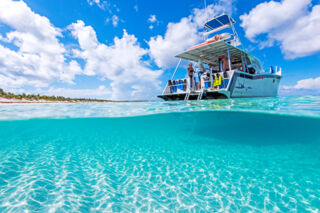Turks and Caicos Scuba Diving

The Turks and Caicos has two features that define local diving: one of the finest barrier reefs in the world and excellent sheer walls.
The Turks and Caicos is situated on an expansive underwater plateau that rises 7,000 feet (2,100 m) from the ocean floor, with most of the islands located directly on the plateau's north edge. The transitions from the 40–50 foot (12–15 m) flat, sandy ocean bottom near land to the vertical walls of the plateau vary, and make for countless interesting dive sites.
The northern edges of the plateau tend to have distinctive spur and groove coral formations, and the western and southern edges offer impressive wall diving. Sand chutes, canyons, and cracks are found at many sites and make for excellent swim-throughs.
Marine Wildlife
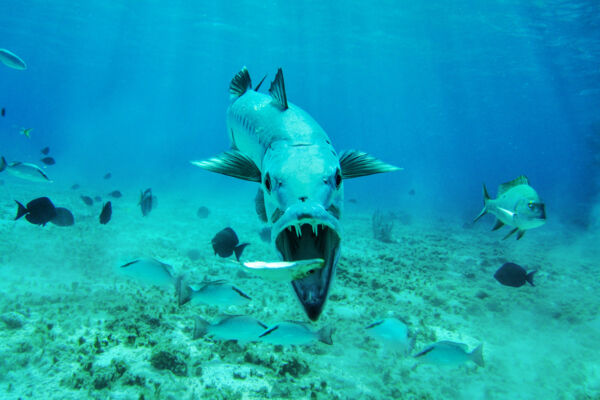
The reefs around the Turks and Caicos Islands support large numbers of colorful Caribbean reef fish and small sea creatures, as well as vibrant corals and sponges.
Most of the sharks you'll spot around the islands are Caribbean reef sharks or lemon sharks, yet hammerheads, nurse sharks, and bull sharks are also found in these waters. Southern brown stingrays and spotted eagle rays are common as well—lucky divers may even see a manta ray.
An entire spectrum of reef fish can be found in the Turks and Caicos. Stoplight parrotfish are one of the most common species, and as they feed on dead corals and excrete them as sand, they largely account for our incredible beaches. Beyond stoplight parrotfish, you can glimpse French, grey, and queen angelfish, snappers and groupers of many types, queen triggerfish, black durgons, filefish, damselfish, trumpetfish, blue tangs, wrasse, jacks, and butterflyfish, just to name a few species, on your dives in the country.
There’s also an abundance of more unusual creatures that you can spot if you look carefully in the sand and crevices of the reef. In crevices and hidden under overhangs are eels, banded coral shrimp, spiny lobsters, slipper lobsters, channel clinging crabs, mollusks, anemones, urchins, starfish, and some fascinating worms. For the best diving experience, take your time and look around!
Each year, humpback whales migrate past the Turks and Caicos during the winter months of January, February, March, and April. Salt Cay tends to be the best for whale watching, but you can also spot whales in the deeper water off the other main islands.
Nearly all popular dive sites in the country are located in protected nature reserves and national parks.
How the Diving Varies Across the Turks and Caicos
The dive companies, facilities, and underwater sights vary according to the island. Before deciding which of our islands you want to vacation on, you should consider several factors.
All-inclusive dive and accommodation packages are available through Beaches Turks & Caicos on Providenciales, but are not offered elsewhere in the country.
The Reefs and Wildlife
First and foremost is what you’ll see underwater. Marine life is vibrant throughout the Turks and Caicos, yet topography differs a bit.
The eastern Turks and Caicos reefs near Grand Turk and Salt Cay support a high density and variety of fish and sea creatures, yet the underwater terrain and coral reef features of the Caicos Islands tend to be more impressive.
The majestic and sheer wall sites of the western Caicos Banks are only accessed from Providenciales and in our opinion are the finest sites in the country.
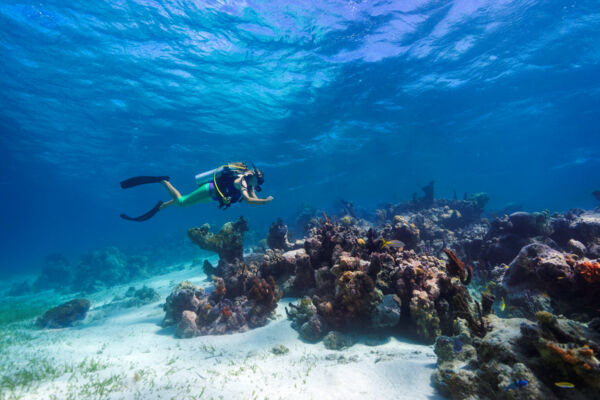
The Boat Trip Out
Grand Turk and Salt Cay feature great sites that are often only minutes from shore. Consequently, most dive companies use smaller, open vessels.
Providenciales is within boating distance of a tremendous range of dive sites, yet some of the better locations, such as French Cay, West Caicos, and Northwest Point, may be as much as an hour’s boat ride away. Because it takes longer to reach these dive sites, Providenciales dive companies commonly use large dive boats and usually have some dry cabin space and restrooms.
The Social Atmosphere
The vast majority of tourism to Grand Turk is by cruise ship, which results in a drastic change in island activity depending on whether a ship is in port. During the day, you’ll see visitors and tours happening across the island, yet at night, Grand Turk becomes much quieter.
The tiny island of Salt Cay only sees around a dozen guests at any one time, so groups are close-knit, and you’ll likely see the same guests and people every day at one of the few restaurants or stores.
Providenciales is where nearly all overnight stays in the Turks and Caicos occur, with most guests staying at one of the island's luxury resorts or villas. The island has more of the tourism atmosphere you would typically experience at other popular destinations.
Non-Diving Attractions
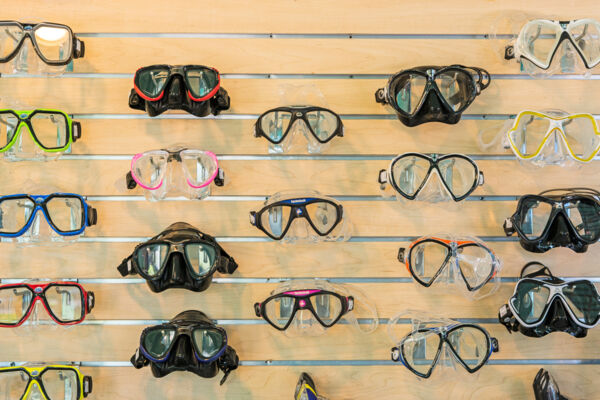
If you’re considering the other activities and attractions available, the situation’s quite simple. Providenciales offers much of the water sports, dining, golf, and spa options, and Grand Turk and Salt Cay have little more than exquisite coastlines and some lightweight historical sights (which may be a good thing!).
Shore and Beach Diving
The Turks and Caicos generally doesn’t offer great shore diving. Grand Turk offers the best conditions, with some acceptable sites fronting a few of the dive shops at Cockburn Town Beach and Pillory Beach. The hotels and resorts of Providenciales are too far from the viable dive sites for shore diving.
Wreck Diving
South Caicos features one resort that offers diving packages. Several interesting sites are found near South Caicos, including a Convair CV-440 airplane wreck and quite a few sites with fascinating reef architecture, including deep crevasses in the barrier reef and small coral caves and grottoes.
The School for Field Studies Center for Marine Resource Studies is located on South Caicos and students regularly dive during their study and research.
Seasons
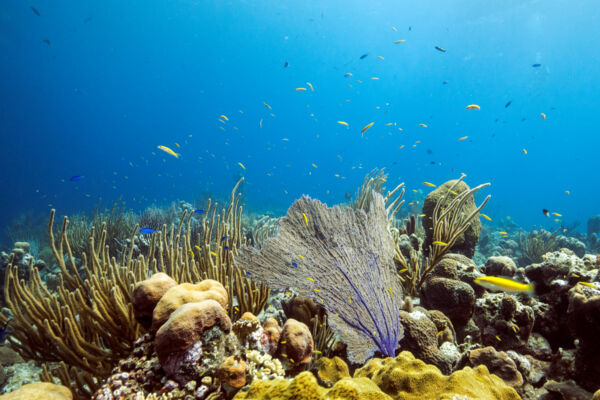
Other than whales and to a lesser degree the larger sharks, all of the common sea animals can be seen year-round. Generally, late summer tends to have the calmest weather and greatest visibility, but this period is also the hurricane season and a big storm can obviously cause major disruptions! Water temperature is generally consistent, reaching a low of about 75° F (24° C) in late January and a high of about 86° F (30° C) in July and August.
Night Diving
Night diving is an amazing change from daytime diving. Because the longer wavelengths (reds and oranges) of light are filtered out before the shorter wavelengths (blues) in the water, everything appears increasingly blue as you descend during unilluminated daytime diving. During a night dive, what you see is lit up by your dive light and because the light travels only the distance from the light to the subject and back to your eyes, the longer wave colors are still vivid. You’ll see everything as it more naturally appears, with brighter warmer colors.
The enhanced colors are only part of the benefits. Many fascinating sea creatures only commonly come out at night, including prawns, marine worms, and lobsters. Sometimes it seems that the reef is busier at night than during the day!
Several local dive companies offer night dives, but these dives are not regularly scheduled and have to be reserved in advance.
Dive Resorts and Accommodations
The Turks and Caicos offers several dive-oriented accommodations. On Providenciales, the country’s largest all-inclusive resort, Beaches, has vacation stays that include unlimited diving trips, as well as a great range of other activities and amenities.
Liveaboard Diving
There are two companies that offer liveaboard diving in the Turks and Caicos: Aggressor Adventures Liveaboards and Explorer Ventures.
Aggressor Adventures runs trips aboard its liveaboard yacht, the Turks & Caicos Aggressor II. This 120-foot (39 m) vessel has accommodations for up to 18 passengers. It departs from Providenciales and visits many sites along the northwest coasts of Providenciales and West Caicos and the remote south banks near French Cay.
A liveaboard is a great choice for scuba diving enthusiasts and dive photographers. You’ll be able to get to many of the remote and exquisite Caicos Banks dive sites and you’ll be among peers, which will likely develop your skills.
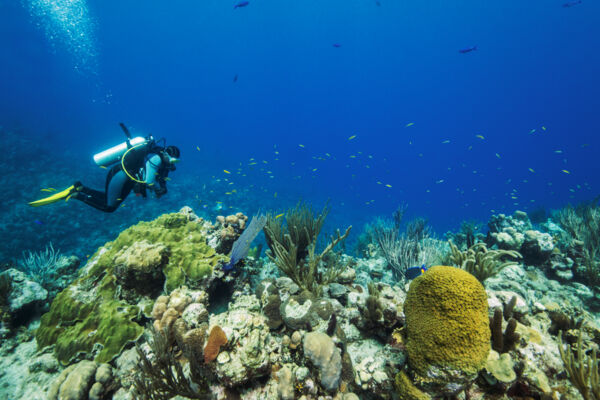
Learning to Dive
It may sound like a cliché, but diving truly opens up an entirely new underwater world. You’ll experience the unique act of breathing underwater and you’ll be able to see an endless stream of fascinating life below the surface.
If you actively swim or snorkel, scuba diving probably won’t be difficult for you to learn. Obtaining a basic scuba diving certification is generally rather easy, but it’s important to understand the risks and dangers involved.
Providenciales, Grand Turk, and Salt Cay all support excellent diving operations, however, Providenciales has by far the greatest selection of dive shops and instructors.
Training and PADI Certification Course
You will need to have completed a certification course and be in possession of your certification card before you are permitted to dive. The foremost certification agency is PADI (Professional Association of Dive Instructors).
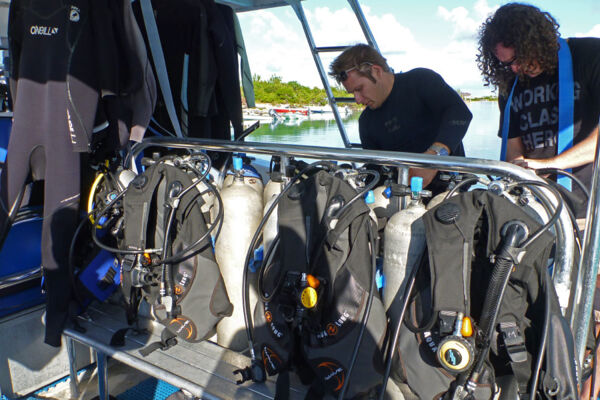
We recommend that most begin with the PADI Open Water Diver course. Open water means there are no overhead obstructions (such as diving in caves or a wreck), and you can surface at any time. The open water course normally has 2 in-pool/classroom days and 1-2 days of certifying dives in the ocean (or other body of water). Depending on the intensity of the course, these may be shortened by a day, but expect to spend 3 or 4 full days getting certified.
A common approach to getting scuba diving is to do the PADI eLearning course online, which costs $190 and takes about 8 hours of study. You take the online test and when you pass, you will need to complete the theory (classroom) portion of your training. You can usually book the pool training at a local scuba club or dive center, and take the in-pool dives locally. Finally, they give you a referral and you do your final, in the water, qualifying dives whilst on holiday, such as in the Turks and Caicos Islands. This way you don’t spend any of your vacation time in a classroom or pool, and, whilst still part of your training, your first dive you get to start ‘real’ diving. You’ll then be certified to dive to 18 meters (60 feet).
Local Dive Companies and Lessons
There are several 5-star PADI Dive Resorts in the country and a few independent instructors.
Most local dive companies offer basic PADI Open Water Diver certification and Nitrox, and some of the larger businesses also teach more advanced courses as well.
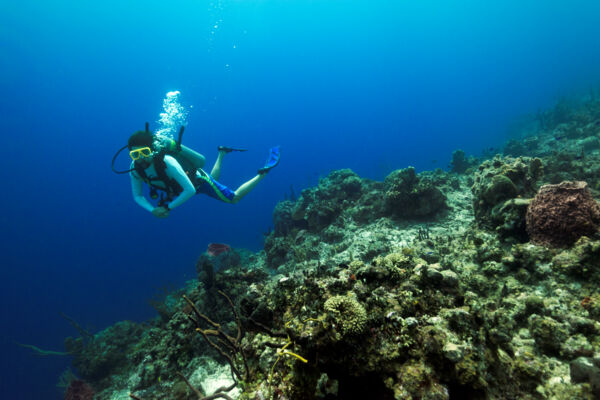
Other Courses
There are two other common dive courses available, the PADI Discover Scuba Diving course and the PADI Scuba Diver course.
The Discover Scuba Diving (also known as a DSD or “resort” course) is basically an introductory course, where you learn about the equipment and dive in a pool or very shallow water. This takes about half a day, and you probably won’t see much at all. The only real point to take this is to get an idea of what scuba could be like.
The PADI Scuba Diver course is similar to the full PADI Open Water Diver course discussed above, but it only covers about 70% of the topics, and you will only be permitted to dive with a PADI Divemaster to depths of 12 meters (40 feet). This means you can complete the course in a shorter amount of time. The Open Water Diver course allows you to dive with just your dive buddy, at depths up to 18 meters (60 feet).
We generally don’t recommend either of these two courses. If you’re interested in diving, you should plan and take PADI Open Water Diver course. These two courses are simply the ‘lite’ version of being a real diver, but you still put in most of the work (and most of the expense).
You can learn more about these courses, and sign-up for eLearning, at the PADI website.
Medical Considerations
You must be in good average health and reasonably fit (but you don’t need to be an athlete) to dive. You shouldn’t fly for at least 12 hours (24 hours is better) after diving.
Decompression Sickness (DCS), one of two types of Decompression Illness (DCI) occurs because of increased levels of nitrogen absorption into your body. This is why you can only be underwater for a limited time (depending on your depth), and then must return for a ‘surface interval’. Nitrogen narcosis (the bends) is caused by bubbles forming in your tissues.
There is a decompression chamber on Providenciales should you encounter DCI.
Providenciales and Grand Turk have modern hospitals, and there’s also a wide selection of private medical practices on Providenciales as well.
Dive Shops
